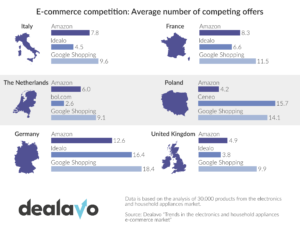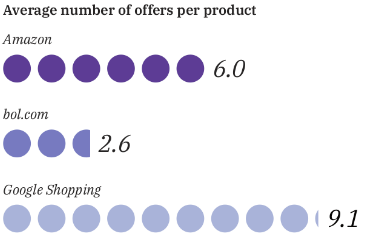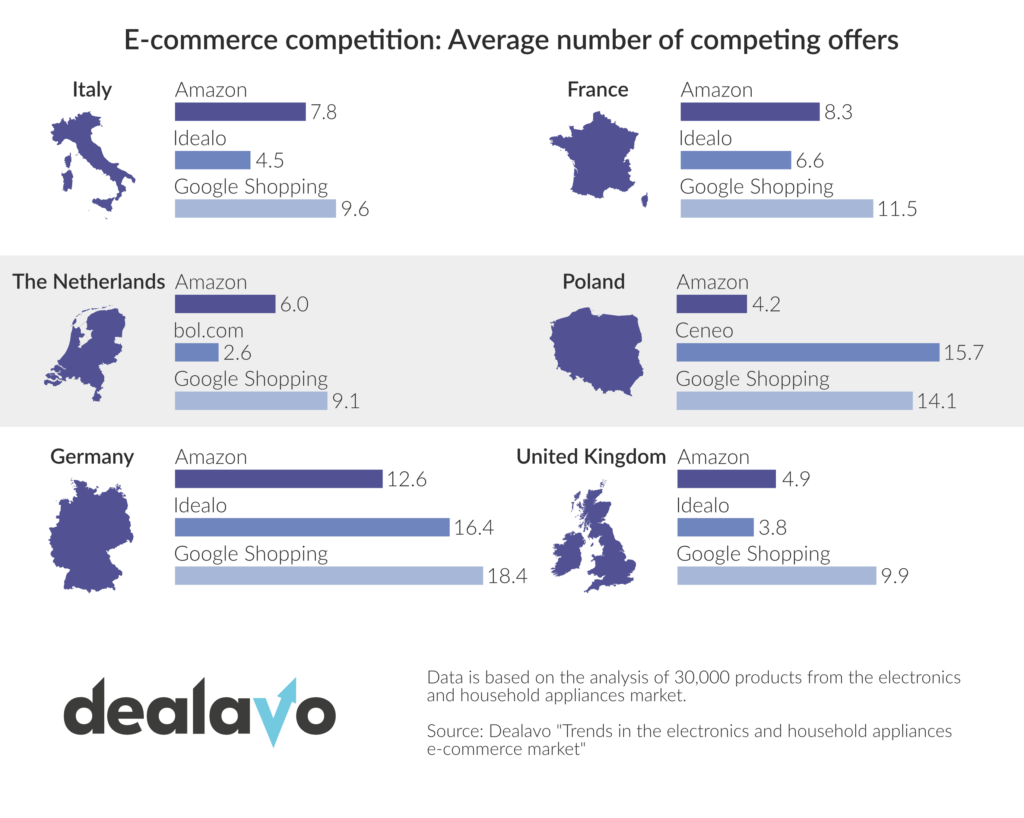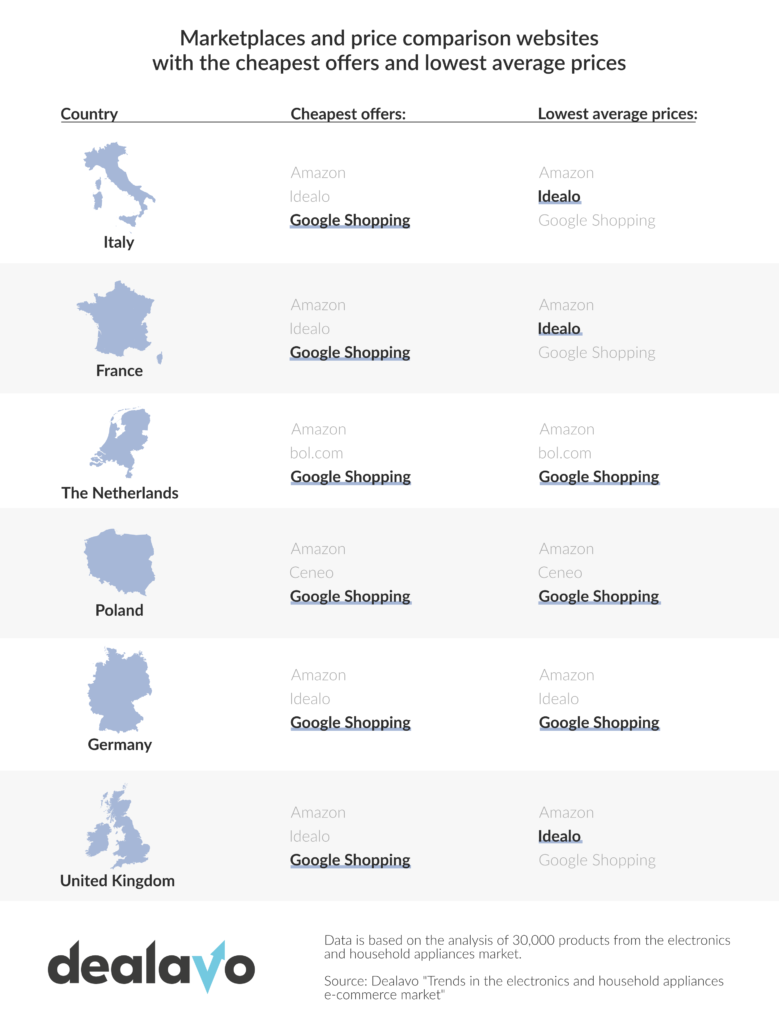
E-commerce market in Europe – how to start selling internationally?
- 08 October 2021
If you run an e-commerce business, the idea of expanding your business abroad has probably crossed your mind. Nowadays it’s easier than ever to sell in foreign countries. One of the reasons is the popularity of international marketplaces and the ease with which a seller can add new countries to the covered markets list. However, the choice of the countries you should start the expansion with might not be straightforward. Below, we present to you some tips and insights that can help you analyze foreign markets and their potential. Most of the data come from the report “Trends in the electronics and household appliances e-commerce market” that focuses on 6 European markets.
International ecommerce expansion – start with the analysis
If you want to expand your business abroad, you should base your decision on data – not only intuition. The key factors to consider when thinking about the international expansion are:
- Popular sales and promotion channels,
- Competition,
- Prices,
- Other factors that can influence your cost.
We analyze them further below.
Popular sales and promotion channels in the European countries
The best way to start the analysis of a specific ecommerce market is by identifying websites where customers usually buy and look for products.
Why?
The first reason is that you can consider starting the expansion by selling on a well-known marketplace as a testing phase. It is significantly easier than setting up a brand new website, requires less effort and marketing investment.
The second reason is that identifying key websites is a good base for further research (of competition, price level etc.). Thanks to that, you will be able to define your strategy based on competitive data.
How can you do it?
If you are not sure which websites are popular in a given country, the lists below can be helpful. You will find there the most popular marketplaces, price comparison websites and online shops in different European countries:
-
- Marketplaces, price comparison websites and top online stores in Northern Europe
- Marketplaces, price comparison websites and top online stores in Western Europe
- Central Europe – Top ecommerce websites
- Marketplaces, price comparison websites and top online stores in Eastern Europe and Russia
- Southern Europe and France – Top ecommerce websites
- Top ecommerce websites in the Balkan countries
You can check Google Trends to see how often keywords related to a specific website are looked for as well.
Apart from that – it’s always a good idea to ask the customers and market players. In our report, you will find some insights from some of them:
Raghib Maqsood, ECPROF, United Kingdom: The most relevant sales channels in the UK include Google, Bing, Amazon, ebay, onbuy and many more. But for us Google and Bing paid advertisement plays an important role in increasing our customer base.
Patryk Borkiewicz, BestMicro, Poland: As far as the Polish market is concerned, Allegro is the biggest player and an undisputed leader. They defended that position after the launch of Amazon early this year and I think they will maintain it in the coming years. Apart from Allegro, there are price comparison websites (including Google Shopping). Global players like Amazon and AlliExpres still have to catch up with the leaders.
Allaz, Netherlands: The most important sales channels in the Netherlands are Google shopping, Google display network, Marktplaats.nl (also for new products) and Beslist.nl.
Pellegrino Lombardi, Eeeshop.net, Italy: Most important sales channels in Italy are Amazon, eBay and ePrice.
How can you analyze competition in different countries?
Once you identify the most relevant sales and promotion channels in a given country (especially marketplaces and price comparison websites), you can check how intense the competition is in each of them. It may turn out that on some of the marketplaces, such as Amazon, you can stand out with your offer easily while on others it is not so simple. As an example, have a look at the differences in competition between different promotion channels in the Netherlands:
Average number of offers per product in the Netherlands in different promotion and sales channels:

Source: Dealavo | Report “Trends in the electronics and household appliances e-commerce market”
As you can see, even though bol.com is a popular price comparison website in the Netherlands, it’s relatively easy to attract customers with your offer there (at least if you sell consumer electronics or household appliances). There are only 2.6 competitors on average that offer a certain product from this category – significantly fewer than on Google Shopping (9.1) or Amazon (6 competitors).
What does it look like in different countries?
European e-commerce market – Competition
Below, you can find statistics from the report about the situation in different countries. In each of the countries 3 websites were analyzed and compared.
 The most competitive sales and promotion channels can serve you to identify the most relevant competitors – retailers offering the same products as you do. Of course, you can do it automatically with a price tracking tool – then, you will get a list of the online shops you have the biggest amount of products in common with. You can then analyze their websites, assortment and value they deliver to better understand your competitive advantage.
The most competitive sales and promotion channels can serve you to identify the most relevant competitors – retailers offering the same products as you do. Of course, you can do it automatically with a price tracking tool – then, you will get a list of the online shops you have the biggest amount of products in common with. You can then analyze their websites, assortment and value they deliver to better understand your competitive advantage.
Price analysis in e-commerce
There is one thing that some online stores tend to ignore. The price level and competition in a different country might be much different from what you are accustomed to. The differences between the most popular marketplaces within a country might be significant as well.
If you want to position yourself as a relatively cheap retailer, you should check whether you can offer truly competitive prices. Don’t forget that it may differ from product to product – that’s why a detailed and ongoing analysis is required. Of course, the usage of a price tracking tool will make this process much easier – if you have a list of products and websites you want to analyze, you can compare your prices with competitors from different channels in one place.
Do you want to know which marketplaces and price comparison websites give customers information about the lowest prices? Check the statistics for the electronics and household appliances products below:

As you can see, if you want to look for the lowest price in the market, checking Google Shopping is usually the safest option. It will usually show you the lowest price of a product that customers can encounter in the market. If it is higher than your price – you will even be able to position yourself as a player with the most attractive price. If this product is a traffic generator (a popular product) – it gives you a great chance to drive traffic to your website!
This analysis will help you better understand where to promote your products and which assortment to choose for that purpose.
Factors that can influence your cost during the international e-commerce expansion
You should remember that a typical cost of serving a customer may differ from country to country. The factors that influence it are legal requirements but also – market standards and customer habits.
Have a look at the comment from ESUS IT – a store rewarded in the report “Trends in the electronics and household appliances e-commerce market”:
You sell in several countries. Do you observe relevant differences between different countries?
Yes, there are differences in various aspects. Payments and payment systems are the first problems you have to deal with. Many countries have different payment systems and their popularity across countries differs. (…) Another aspect is the language support – there are countries in which the chances to sell are slim if you don’t offer everything in the native language. The priorities are different as well – for example, delivery time for northern European countries is not crucial for the purchase decision but in Germany the delivery time must be fast, because this is one of the key elements for customers. Our company offers both new and used products. There are markets where used products are the first choice for customers, while in others they are bought only when the new products are unavailable. (…) When we launch foreign markets we are aware of cultural differences or some characteristics of purchasing behavior.
In general, there are a few key factors to take into account (apart from prices and the competition):
- Delivery – How popular is free shipping? Is quick delivery crucial for online shoppers? In some countries, free delivery is a standard and you can lose several customers if you don’t offer it. However, there are some tricks that can make it more beneficial to the company as well. Check our article about free shipping to learn more.
- Customer habits – how often do customers return purchased goods? In some countries, such as Germany, it is more common than in others – more than half of online shoppers return at least one product in a year.
- Preferred payment methods – make sure you can offer the payment method that is popular in a given country – for example, in the Netherlandsdebit cards are popular while Germans prefer online bank transfers. If you don’t analyze it early enough, it can lead to many abandoned shopping carts.
- Foreign exchange fluctuations – if exchange rate fluctuates significantly, it can influence your profit – especially if you bear costs in your home currency and gain revenue in a foreign one. You should think about securing against the profit losses before entering the new market.
Cross-border ecommerce: summary
If you want to expand your ecommerce internationally, you should prepare your business adequately. Start with the analysis to properly choose:
- Countries to expand your business to,
- Sales and promotion channels,
- Prices of products from your assortment,
- and more.
If you need help in the area of pricing – fill the contact form on our website. We will be happy to help.